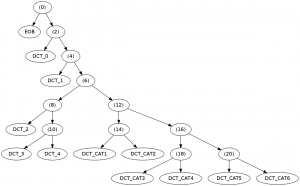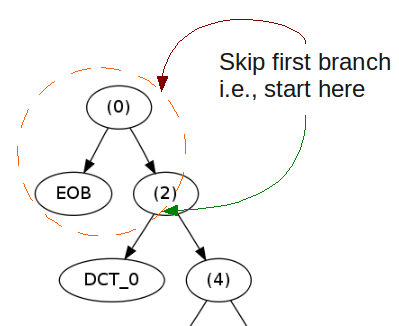I got tripped up on another part of the VP8 decoding process today. So I drew a picture to help myself understand it. Then I went back and read David Conrad’s comment on my last post regarding my difficulty understanding the VP8 spec and saw that he ran into the same problem. Since we both experienced the same hindrance in trying to sort out this matter, I thought I may as well publish the picture I drew.
VP8 defines various trees for decoding different syntax elements. There is one tree for decoding the tokens and it is expressed in the VP8 spec as such:
Here is what the table looks like when you make a tree out of it (click for full size image):

The catch is that it makes no sense for an end-of-block (EOB) token to follow a 0 token since EOB already indicates that the remainder of the coefficients should be 0 anyway. Thus, the spec states that, “decoding of certain DCT coefficients may skip the first branch, whose preceding coefficient is a DCT_0.” I confess, I didn’t understand what “skip the first branch” meant until I drew the tree.

For those wondering why it might be sub-optimal (clarity-wise) for a spec to simply regurgitate vast chunks of C code, this makes a decent case. As you can see, the spec makes certain assumptions about how a binary tree should be organized in a static array (node n points to elements n*2 and n*2+1 as its branches; leaves are either negative or 0). This is the second method I have seen; another piece of code (not the VP8 spec) had the nodes in the first half of the array and pointed to leaves in the second half. There must be other arrangements.
Reminds me of three or four different VLC reading techniques employed in RealVideo decoder. And somebody said about your company flag product “one can guess when certain element was added to Photoshop by the look of its interface”, I suspect we have the same story here.
Could this research end up as a stub for a native VP8 decoder in ffmpeg?
@RV: FFmpeg’s native VP8 decoder is already well under way. Not by me, though.